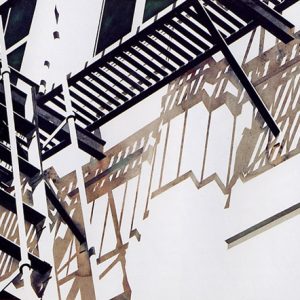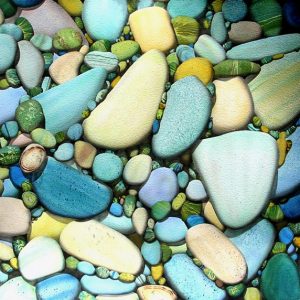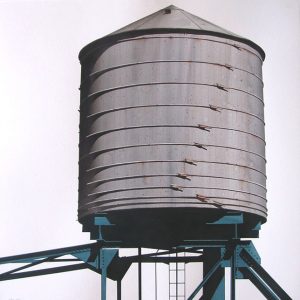calsfoundation@cals.org
George David Dombek (1944–)
The visual artist George Dombek is a nationally recognized master of watercolor. His work has been acquired by major museums and corporate collections, including two paintings and a sculpture in the Crystal Bridges Museum of American Art in Bentonville (Benton County).
George Dombek was born on June 18, 1944, in Paris (Logan County), an economically depressed mining town of about 3,000 at the time. He always had an extremely strained relationship with his father, Stanley Dombek, a coal miner who lost his job when Dombek was in high school and eventually died of black-lung disease. Any encouragement he received came from his mother, Lillian Shirley Dombek, who supported the family of six after her husband became unable to work by working as a cook. George Dombek also had a severe speech impediment, which made it difficult for him to succeed in school.
After high school, Dombek went to Arkansas State Teachers College (now the University of Central Arkansas) in Conway (Faulkner County) but got poor grades and soon dropped out. He then supported himself for five years in a succession of jobs, mostly in building, highway work, and pipeline construction. Before the age of eighteen, he had never seen an original work of art, visited a museum, or met an artist or architect. However, he soon encountered reproductions of paintings by Jackson Pollock and Franz Kline in Time magazine, and, thinking they looked easy to do, he set out to make paintings resembling them. A little while after, while working in a furniture store, he discovered reproductions of paintings by Maurice Utrillo and again attempted to make paintings of a similar sort.
A friend who saw some of these works suggested he enter architectural school. Consequently, Dombek enrolled in the architectural design program at the University of Arkansas (UA) in Fayetteville (Washington County), where, for the first time in his life, he academically excelled, receiving straight A’s and even being assigned a class to teach. Around this time, he also received speech therapy, which made social interaction easier for him.
One summer, he took some classes in watercolor in the art department, where his talent was immediately recognized. After graduating with a BA in architecture in 1974, he went into the master’s program in art, where he studied for three years with Robert Ross as his mentor, receiving his MFA in 1977. During most of this period, he concentrated on landscape and nature scenes inspired by Vincent Van Gogh and Charles Burchfield.
Toward the end of this period, however, he took the instruments of an architect—straight-edge, T-square, and triangle—and created a painting of crates piled up in a barn in topsy-turvy fashion. Rather than being something he had observed, the design was “constructed” from imagination. This established the direction he has pursued in most of his subsequent work.
Dombek’s early work tended to feature manmade subjects, such as fire escapes, tobacco barns, steel foundries, and bicycles; in 1989, during a trip to Italy, he was inspired to paint beach stones. From this time onward, natural objects such as birds, butterflies, flowers, and branches alternated with his manmade subjects. Over the years, his work has also grown more provocatively surreal, for example, with paintings of bicycles in trees or of branches that echo the design of famous statues or paintings. Most of his work consists of “constructed realism” and employs an elaborate process of masking out different areas and of applying watercolor pigment in different ways—such as pouring it in fluid washes, applying it with a brush, or using a spray-gun. The strong design quality of his paintings, and the skillful division of an image into patterned areas, often evokes a sort of patchwork quilt.
From 1977 to 1980, Dombek supported himself as an architectural draftsman in San Francisco, California. In 1980, he took a job teaching architecture at Florida A&M University in Tallahassee, where he was employed until 1996. During this period, he sent watercolors to exhibitions at university art galleries around the country, receiving acclaim from jurors and art critics and winning prizes in about half the competitions he entered. The income he received from prizes and awards, however, just barely covered the expenses for materials and shipping.
In 1996, he returned to Arkansas, settling in Goshen (Washington County), where he constructed a home and studio in order to paint full time. At the end of that year, he was deeply in debt, as the cost of building his house and studio had gone significantly over budget. In the ensuing years, however, he gradually gained recognition, especially in northwestern Arkansas, and has been generously supported by local patrons, notably Tyson Foods, which owns a collection of more than 100 of his paintings. His works, including paintings and a sculpture, are in the collection of the Crystal Bridges Museum of American Art. Over the years, his studio complex had expanded to roughly the size of a community art center, and it is now a popular destination for art tours.
He is married to Sandra Twiggs and has no children.
For additional information:
Adams, Henry, and George Dombek. George Dombek. Fayetteville: University of Arkansas Press, 2014.
Dombek, George, and Donald Harington. On a Clear Day: The Paintings of George Dombek, 1975–1994. Conway: University of Central Arkansas Press, 1995.
George Dombek. http://georgedombek.com/ (accessed October 22, 2020).
Henry Adams
Case Western Reserve University

 The Coffee Group
The Coffee Group  San Francisco Windows
San Francisco Windows  Trout Island
Trout Island  Water Tower 443 Greenwich St
Water Tower 443 Greenwich St 



Comments
No comments on this entry yet.